Triumph Engineering Co Ltd was a British motorcycle manufacturing company, based originally in Coventry and then in Meriden. A new company, Triumph Motorcycles Ltd, based in Hinckley, gained the name rights after the end of the company in the 1980s and is now one of the world's major motorcycle manufacturers.

The Triumph Triples are a family of modern DOHC inline three-cylinder motorcycle engines made from 1990 onwards by the Triumph Motorcycle Company at their Hinckley, Leicestershire factory. The inspiration for the later triples was the pushrod Triumph Trident, produced from 1968 to 1974 at the Triumph factory at Meriden Works.

The Triumph Trident and BSA Rocket 3 was a technically advanced, high-performance roadster motorcycle made by Triumph Engineering and BSA from 1968 to 1975, and sold under both the Triumph and BSA marques. Alongside the Honda CB750, and later the two-stroke Kawasaki triples, it brought a new level of sophistication to street motorcycles, marking the beginning of the superbike era. The Honda CB750 overshadowed the Trident to be remembered as the 'first superbike', in spite of the Triumph Trident actually debuting before the Honda by a few weeks.

The Triumph Bonneville is a standard motorcycle featuring a parallel-twin four-stroke engine and manufactured in three generations over three separate production runs.
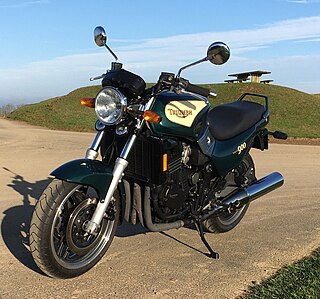
The Triumph Trident is a three-cylinder motorcycle of either 750 cc or 900 cc capacity. These bikes were produced from 1991 to 1998 at Hinckley, Leicestershire, England, by Triumph Motorcycles Ltd, the successor business to the defunct Triumph Engineering at Meriden Works, Warwickshire, England.

The L-twin is a naturally aspirated two-cylinder petrol engine by Ducati. It uses a 90-degree layout and 270-degree firing order and is mounted with one cylinder nearly horizontal.
The Ducati SportClassics are a range of retro styled motorcycles introduced by Ducati at the 2003 Tokyo Motor Show, and put on sale in 2005 for the 2006 model year. The Paul Smart version was made for the 2006 model year only, while the Sport1000 ran from 2006 through the 2009 model years, and the GT1000 ran from the 2007 through 2010 model years.
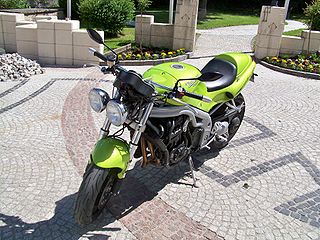
The Triumph Speed Triple is a series of motorcycles produced by Triumph Motorcycles. The 1994 Hinckley Triumph was one of the first motorcycles produced in the streetfighter style. The style originated with bikers who, having crashed their race replicas, put the bikes back on the road without fairing, and has since become popularised.

The Norton Commando is a British Norton-Villiers motorcycle with an OHV pre-unit parallel-twin engine, produced by the Norton Motorcycle company from 1967 until 1977. Initially having a nominal 750 cc displacement, actually 745 cc (45.5 cu in), in 1973 it became an 850 cc, actually 828 cc (50.5 cu in). It had a hemi-type head, similar to all OHV Norton engines since the early 1920s.

The Tiger 100 (T100) was a standard motorcycle first made by the British motorcycle company Triumph in 1939. Production ceased when the Triumph factory was destroyed by German bombing in 1940 during World War 2, but recommenced in 1946. Several variants were manufactured until 1973.

The T140W TSS was the last motorcycle model made by Triumph Engineering at their Meriden factory.

Triumph Motorcycles Ltd is the largest UK-owned motorcycle manufacturer, established in 1983 by John Bloor after the original company Triumph Engineering went into receivership. The new company, initially called Bonneville Coventry Ltd, continued Triumph's lineage of motorcycle production since 1902. They have major manufacturing facilities in Thailand.
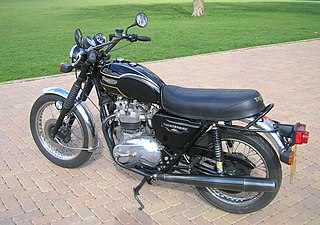
The Triumph TR65 Thunderbird is a motorcycle made by the Triumph worker's co-operative at the Meriden factory from 1981 to 1983. The TR65 was a reintroduction of the Triumph Thunderbird model name first used on the original 6T Thunderbird of 1949. A short stroke model, the Daytona 600 was designed in 1983 but not produced.
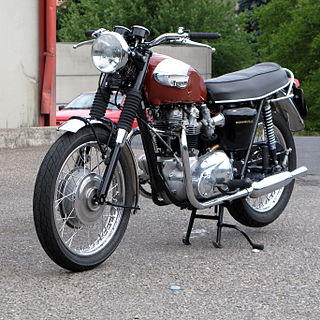
The Triumph Bonneville T120 is a motorcycle originally made by Triumph Engineering from 1959 to 1975. It was the first model of the Bonneville series, which was continued by Triumph Motorcycles Ltd. The T120 was discontinued in favour of the larger 750 cc T140 in the early 1970s.
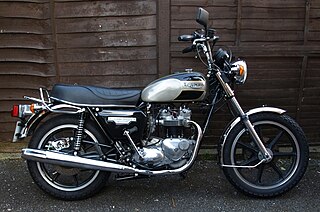
The Triumph Bonneville T140 is a standard motorcycle with a 750 cc (46 cu in) capacity engine that was designed and built by Triumph Engineering at Meriden near Coventry.

Norman Hyde is a British motorcycle development engineer, racer, and world record holder.

The Triumph Scrambler is a British motorcycle made by Triumph Motorcycles. Launched in 2006, it was the last Triumph styled by designer John Mockett, who had begun working with the small factory team at Triumph in 1989, rationalising existing models based on a very successful modular design plan, including the concept and styling of the unfaired Trident triples for their 1990 IFMA launch. Mockett subsequently served as principal stylist for most of the bikes introduced up to 2006.
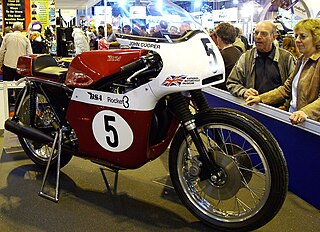
The BSA/Triumph racing triples were three cylinder 750 cc racing motorcycles manufactured by BSA/Triumph and raced with factory support from 1969 to 1974. There were road racing, production racing, endurance racing and flat track variants. The machines were based on the road-going BSA Rocket 3/Triumph Trident.

The Triumph Trophy is a three or four-cylinder touring motorcycle of either 885 cc or 1,180 cc capacity. These bikes were produced from 1991 to 2003 at Hinckley, Leicestershire, England, by Triumph Motorcycles Ltd, the successor business to the defunct Triumph Engineering at Meriden Works, Warwickshire, England.

The Triumph Daytona and Daytona Super 3 is a three or four-cylinder British sports motorcycle. These bikes were produced from 1991 to 1996 at Hinckley, Leicestershire, England, by Triumph Motorcycles Ltd, the successor business to the defunct Triumph Engineering at Meriden Works, Warwickshire, England.




















